In the insulation department of any building supermarket, a place is allocated for penofol. Thin roll material with a foil surface attracts attention, but its appearance does not always answer the question of where it can be applied.
However, it successfully occupies a whole niche in the field of home insulation, where familiar insulation, such as mineral wool or expanded polystyrene, will not help adequately cope with the task.
Penofol is a practical and inexpensive insulation made of uncrosslinked polyethylene foam with aluminum foil applied to one or both sides of the material. Gas-filled cells are sealed and closed type, which provides high compressive strength, but does not interfere with the bending of the material. The size of the cells is usually from 0.5 to 2 mm.
Instead of aluminum foil, lavsan is also used, a polymer material with good reflectivity in the infrared frequency range of electromagnetic waves.
Its advantage in dielectric properties is does not pass electric current, which is especially important when arranging electric warm floors.
Insulation stands out from the rest at an affordable price and in a simple way installation, however, due to limitations in thickness, it is used in a rather narrow number of cases, where it is only necessary to supplement the existing enclosing structures, increasing the total resistance to heat loss.
Penofol found the main field of application in air conditioning and thermal insulation systems, where the bulk of the heat is transferred using infrared radiation.
Three versions of penofol are produced:
- Type A - with one-sided foil;
- Type B - with double-sided foil;
- Type C - foiling on one side and self-adhesive surface on the other side.
The choice of a suitable option is determined by the direction of propagation of the target thermal radiation. For example, one-sided penofol when mounted on the wall of a dwelling, when the foil surface is turned inward, protects against heat loss from the inside of the house to the outside. This means that it will be warmer in the house in winter.
Double-sided penofol is able not only to suppress heat loss from the house to the street, but also the flow of heat from the outside. So it will be warm in winter and not hot in summer, since the heat from the walls, irradiated by sunlight, will not overheat the air inside the room.
Specifications
 A significant part of the thermal energy is distributed in the form of radiation, and therefore the heat-reflecting surface of penofol makes it possible not only to slow down heat loss, but to turn the heat back into the room in winter or prevent it from outside in hot summer.
A significant part of the thermal energy is distributed in the form of radiation, and therefore the heat-reflecting surface of penofol makes it possible not only to slow down heat loss, but to turn the heat back into the room in winter or prevent it from outside in hot summer.
A layer of polyethylene foam acts as a strong and durable base for the aluminum screen, and at the same time copes with thermal insulation in the usual way, increasing the thermal resistance of the fences. That is why it is difficult to compare penofol with traditional heaters with a simple calculation.
The material is based on a layer of foamed polyethylene with a thickness of 3-10 mm, on top of which a layer of aluminum with a thickness of only 14 microns is applied.
Aluminum even this thick copes well with reflecting up to 97% of thermal radiation, while foamed polyethylene provides thermal insulation in the classical way, preventing convection heat transfer.
| Characteristic | Unit. | Type A | Type B | Type C |
| Operating temperature | ºС | -60 .. + 100 ° C | ||
| Thermal reflection coefficient | % | 95-97 | ||
| Coefficient of thermal conductivity | W / m * K | 0,037-0,049 | 0,038-0,051 | 0,038-0,051 |
| Water absorption by volume | % | 0,7 | 0,6 | 0,35 |
| Specific gravity with a thickness of 4 mm | Kg / m3 | 44 | 54 | 74 |
| Dynamic modulus of elasticity under load 2kPa | MPA | 0,26 | 0,39 | 0,26 |
| Vapor permeability | Mg / m * h * Pa | 0,001 | ||
| Compressive strength | MPa | 0,035 | ||
| Specific heat | J / kg * K | 1,95 | ||
To compare penofol with other materials, it is clearer to use the value of the total resistance to heat transfer R under equal operating conditions and a difference of external and internal temperatures of 40 ° C.
For example, penofol with a thickness of 3 mm Type B (double-sided foil), according to tests, creates a resistance equal to 1.173-1.064. Similar resistance provides:
- 1.7 m of concrete;
- 77.40 cm of expanded clay concrete;
- 11.70 cm of wood (oak);
- 55.0 mm mineral wool (stone);
- 42.2 mm EPS;
- 36.0 mm expanded polystyrene;
- 31.7mm PU foam.
The numbers are impressive, but such results can only be achieved if the operating rules are observed and provided that the main source of heat transfer is radiation. Simply put, in the absence of active convection air currents in the heated room.
What is it needed for
The main feature of penofol is the presence of a heat-reflecting screen. It is indispensable for insulation:
- walls and ceilings as part of multi-layer enclosing structures;
- balconies and loggias;
- pitched roofs, mansards and attics;
- utility rooms and outbuildings;
- greenhouses;
- a heat-reflecting screen as part of a floor heating system;
- niches with an installed heating radiator;
- air conditioning systems for freezers;
- pipes and lines with refrigerant or heat carrier within the permissible operating temperatures.
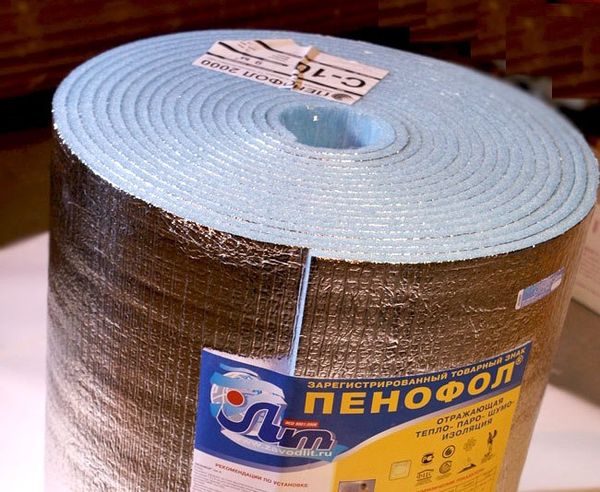 In addition to the heat-insulating heat-reflecting properties, penofol has practically zero vapor permeability. It is used for effective and unique waterproofing properties in the composition roofing cake... H only from the inside of the attic or attic.
In addition to the heat-insulating heat-reflecting properties, penofol has practically zero vapor permeability. It is used for effective and unique waterproofing properties in the composition roofing cake... H only from the inside of the attic or attic.
Covering all the advantages, penofol is ideal for arranging isolated heat-efficient premises: greenhouses, incubators, vegetable stores, for protecting basements and semi-basements.
Thanks to the sealed closed structure of polyethylene foam, penofol has good sound insulating properties. Basically, it absorbs shock sound, vibration, but it is less resistant to high-frequency sounds and noise.
As a substrate under flooring, as well as under a thin screed, it will absorb the sound of footsteps or impacts on the floor.
Floor insulation. Under the screed
When insulating a floor, penofol is used as a substrate for all types of screeds, wet, semi-dry, dry, bulk or made with any sheet material, as well as a substrate for all types of flooring.
This is facilitated by the high compressive strength of the material and the dynamic modulus of elasticity is much higher than that of any other insulation.
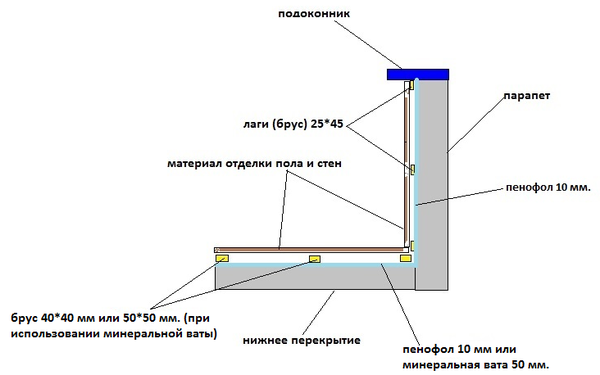
Floor insulation scheme
Polyethylene provides strength to air bubbles, which in turn provide uniform cushioning for any distributed loads.
Taking into account the horizontal distribution of foam foam, it is not necessary to attach it additionally to the base.
When arranging a warm floor or fixing a reinforcing layer, any damage to the foam foil surface should be minimized so as not to violate the integrity of the foil layer.
Balcony insulation
For insulation of a balcony, penofol is an ideal heat-insulating material. In conditions of extremely limited space, it will be necessary to subtract only 20 mm from each fence in order to insulate the room with foam foam, taking into account the mandatory gap between the insulation and the finish to form a closed air chamber.
There are two mounting options:
- Uniform laying of the material end-to-end over the entire insulated surface and installation of the lathing for further finishing on top of it;
- First, a lathing made of 40x40 mm timber is attached, and after that, insulation is distributed in each cell with an approach to the elements of the lathing.
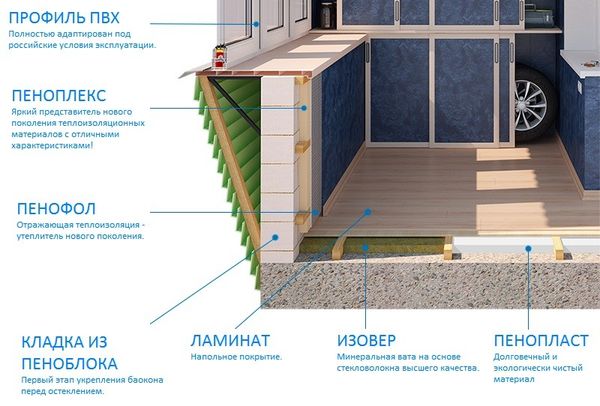
Balcony insulation scheme
In both cases, you do not need to use adhesives or a large number of fasteners. In the first case, the insulation will reliably press against the base with the crate, and in the second case, it is enough to attach the penofol under the very base with a stapler to the same crate.
The choice of the best option is determined based on the required loading capacity of the lathing and the weight of further finishing.
How to fix
The basis for penofol is polyethylene, which, unfortunately, has very weak adhesion to construction adhesive solutions.
For fastening, mechanical methods are used: self-tapping screws with a press washer, stapler brackets, clamping strips, fixing under the crate. When laying on a horizontal surface under a screed, fastening is not necessary at all.
All joints and attachment points, where the material has been stitched through, are sealed with special tape made of thick aluminum foil or polymer base with aluminum spraying. This will restore the tightness of the insulation layer and give additional strength to the insulation.
Foil self-adhesive
 As an additional fastening, double-sided tape can be used along the edges of the foam strip. However, manufacturers provide an even better option. The self-adhesive surface of "type C" penofol extremely simplifies installation on any clean prepared surface.
As an additional fastening, double-sided tape can be used along the edges of the foam strip. However, manufacturers provide an even better option. The self-adhesive surface of "type C" penofol extremely simplifies installation on any clean prepared surface.
One side of the material is completely covered with an adhesive with the same properties as conventional tape, covered with a protective film.
If you need to glue a small screen, for example, on a wall behind a battery, where it is inconvenient to attach it in other ways, then self-adhesive foam foam is the best practical solution.
Enough prepare the surface, clean, degrease and, if necessary, primeso that it does not get dusty.
Izolon or penofol: which is better
Penofol can be compared with only one group of heat-insulating materials of the Izolon trademark, namely "Izolon heat-reflecting insulation".
The company ISOLON offers insulation materials based on polyethylene foam (ISOLON 100) or cross-linked polyethylene foam (ISOLON 500) with aluminum foil or lavsan applied on one side.
Comparing Isolon 100 and penofol, there is no significant difference in properties and method of application, so the final winner will have to be determined in terms of availability and cost. Izolon's only advantage is that the assortment has been expanded with sheet material with a thickness of 15 to 50 mm.
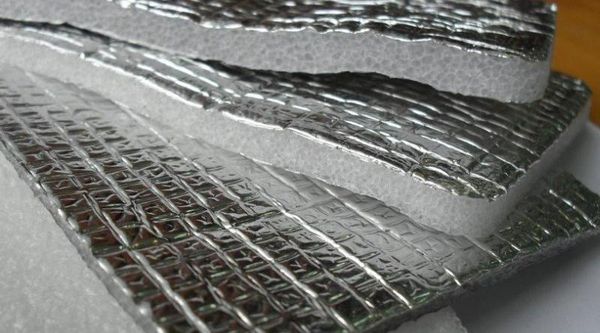 Isolon 500 thermal reflective insulation is made from cross-linked polyethylene foam, which gives it much more strength and a slightly lower coefficient of thermal conductivity. Depending on the expansion rate (5-40 times), the compressive strength at 10% deformation ranges from 0.011 to 0.15 MPa.
Isolon 500 thermal reflective insulation is made from cross-linked polyethylene foam, which gives it much more strength and a slightly lower coefficient of thermal conductivity. Depending on the expansion rate (5-40 times), the compressive strength at 10% deformation ranges from 0.011 to 0.15 MPa.
In most cases, it is enough to use penofol, however Izolon makes it possible to use heat-reflecting screens even in cases where the performance characteristics go beyond the permissible limits for penofol.
Penofol is a reflective insulating multilayer material consisting of a main body and polished aluminum foil. Depending on the required properties, polyethylene foams are used as the basis for foam foams, which have different physical characteristics depending on the thickness and structure. There are two main types - foil and non-foil.
Non-foiled penofol has found fewer ways of application, since when using only a gas-foam base, its main property is lost - thermal insulation. Foams in this form are used for civilian purposes - all kinds of camping rugs, bedding for pets, etc.
If you do not need reflective properties for insulation, you can use a non-foil base as a layer for insulation of floors, walls, ceilings and pipes, since its application temperature varies from -40 to + 100 ° C, which meets the basic operating conditions. This type is considered an outdated insulating material, it was replaced by a more advanced technology - the application of a thin metal coating.
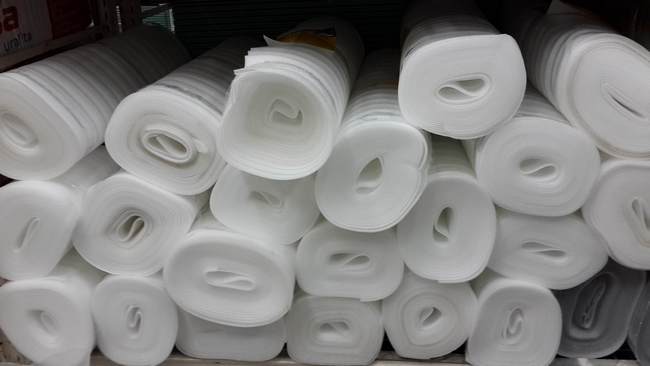
Reflective material is applied to the foil using thermal welding technology. A polished canvas with a reflection coefficient of 96-98% has a thickness of up to 0.1 mm, while the thickness of the main foam material ranges from 1 to 25 mm, in the case of individual orders it can reach 50 mm (this option is usually used in extremely cold climates).
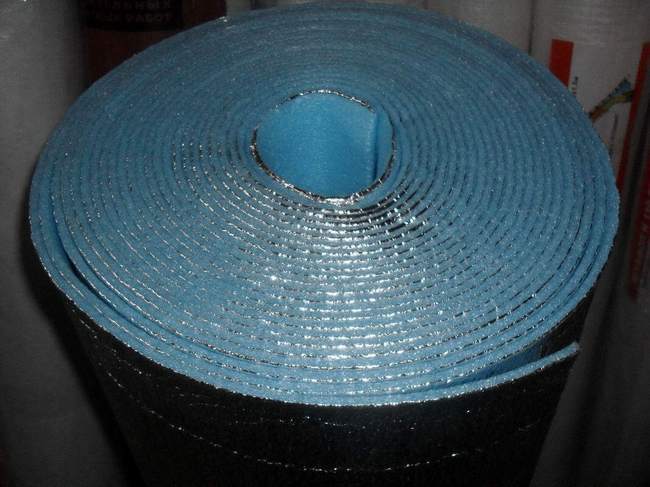
Classification of foil penofol
Depending on the field of application and the required operational properties, the modern building materials market offers the following types of foam foam:
- Marking "A" - has a reflective aluminum coating on one side only. Most often, this type is used in conjunction with other insulation materials such as polystyrene or expanded polystyrene. The most common, used as insulation in living quarters, has vapor reflecting properties.
- Marking "B" - foil coating is applied on both sides, which allows its use as an independent insulation. With a sufficient thickness of the main layer, you can insulate the floor or walls only with it. The upper part of the reflector will retain heat inside the room, reflecting it back into the room, while the lower part will protect you from cold penetrating through the walls from the environment.
- Marking "C" - this modification has a reflective coating only on one side, on the other side moisture and heat resistant glue is applied. This type allows you to use it in hard-to-reach places, as well as insulate walls and ceilings without any difficulties in installation.
- Modifications "R" and "M" have a one-sided aluminum coating 0.14 mm thick, applied to the embossed structure, while the other side is flat. Such indicators, different from the standard ones, provide increased sound, heat, and moisture insulation. These modifications are used for external structures, as the relief structure provides maximum sound insulation. They are recommended for use in multi-layer structures.
- SuperNet marking means that this type of foam foam has increased resistance to aggressive environmental conditions due to the increased thickness and density of the gas foam base. It is used to isolate communication networks, water pipes and heating mains - in places that need maximum insulation performance.
- Laminated (modification "ALP") - has a one-sided foil coating on which a polymer film is applied. It is used as a reflective element in the "" system, laying directly under the heating elements with the foil side up. Thus, the heat generated by pipes or heating elements is reflected upward, without wasting on heating the lower part of the floor. Lamination increases the resistance of the aluminum coating to the heat generated from the heating elements.
- AIR marking perforated penofol is designated - a material that has through holes in its structure. It is used for external insulation of structures, the perforated structure allows steam emissions from the structure to pass outside. This type is recommended to insulate cold walls. frame houses in multi-storey buildings.
Internal and external insulation of premises
For domestic needs, it is enough to use the first three modifications of penofol - A, B and C. The scope of this material as insulation is very extensive: floor, walls, ceiling, insulation of balconies, terraces and loggias, insulation of wooden and frame houses. Below are the insulation technologies.
Floor insulation
Before laying the insulating layer, you first need to level the original surface with a thin concrete screed. For this, a slurry of cement is mixed and poured, then it is allowed to dry completely. It is not recommended to lay penofol right away - usually a layer of foam plastic with a thickness of 7-15 cm is used.
Further actions are related to the selected type of penofol:
- If modification "A" is used, then a moisture-resistant adhesive-filler is evenly applied to the foam, on which the insulating material is tightly laid.
- In the case of material marked "C", no glue is needed, as it is already applied to the side opposite to the reflector. When making this modification, the waterproof glue is immediately covered with a layer of polyethylene to prevent it from drying out prematurely. To start laying penofol, the polyethylene layer is carefully removed, then the material is carefully rolled out over the surface of the foam.
The material is laid with a five-centimeter overlap on the walls, all joints must be glued with aluminum insulating tape. This will allow you to achieve the maximum vapor and moisture insulation effect and protect the floor from impact noise. After finishing laying the floor, the protruding parts of the insulating material are carefully trimmed with an assembly blade.
When designing a "warm floor" system, there are two main types of subsequent installation - the use of a log and a concrete screed. It is recommended to use logs if you want to make a wooden floor over the insulated layer. To do this, it is necessary to lay wooden logs along the entire floor over the heating elements (it is recommended to pre-treat them with antiseptic preparations or soak them with special hydrophobic oils).
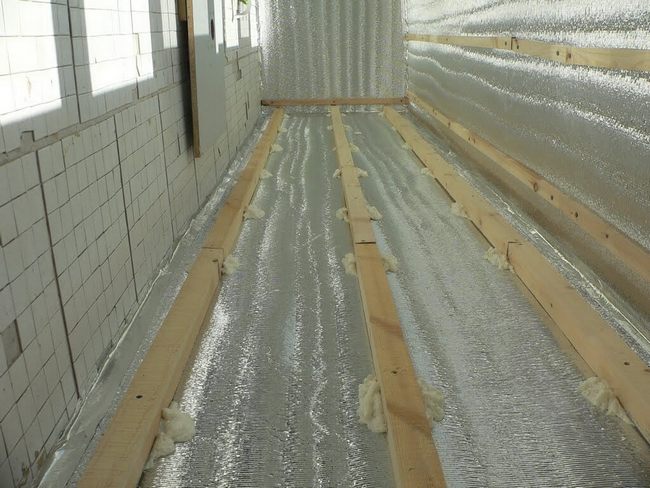
The horizontalness of the installation of the bars should be controlled using a level. Then boards or other options for wooden floors are stuffed on top of the laid bars. Thus, the heat emanating from the heating elements will be reflected upwards by the foil covering, warming up the wooden floor.
The second option is to install the "warm floor" system under the tiles or a natural stone... To do this, the heating elements are covered with a thin reinforced mesh and poured with a concrete screed, or they are placed in a layer of tile adhesive of the retainer. Please note that in this case it is necessary to use penofol marked "ALP". A layer of polymer film-laminate will protect thin aluminum foil, since the action of cement mortar or glue-fixative has a destructive effect on it.
Wall insulation
When insulating interior walls the room is recommended to use penofol marked "B". Its installation is more complicated and time consuming than modifications "A" and "C", but it is capable of providing more serious insulation protection. For better sound and heat insulation, ventilation gaps are created between the wall and the foam foam.
If a material with one-sided foil can be glued directly to a wall or to a heavier insulation (thick foam layer), then installation with a double-sided metal coating takes place according to the following technology:
- Using dowels, wooden blocks 1-2 cm thick are attached to the wall;
- A layer of foam foam marked "B" is screwed onto them or nailed with mounting brackets;
- Drywall is applied to the surface of the insulating material, which is attached to the rail with self-tapping screws. If you decide to leave cavities for ventilation on the other side of the foam, then first, slats with a thickness similar to the previous ones are screwed onto it, and only then the drywall is fastened. You will lose 2-3 centimeters of space in the room, but provide very good insulation with two airbags.
Penofol joints must be carefully glued with aluminum insulating tape to avoid drafts.

Ceiling insulation
Indoors, it follows from gluing a thin layer of foam foam to the original coating. It will serve as a primary insulating barrier, onto which wooden slats are then screwed, which act as a frame for the main insulation layer.
After mounting the rails, a second, already thick layer is attached to them, which is attached to the frame using a construction stapler or self-tapping screws. If another layer of insulation is required, the previous layer of insulation is also fastened with wooden battens, on which the third layer is mounted in the above way.
To create conditions for decorating the room, drywall is glued or screwed to the last level.
The formation of one or more air cushions ensures the highest insulation values, while the accumulated condensation in them will be removed by ventilation. Do not forget to process the joints of penofol with construction tape or silicone glue.
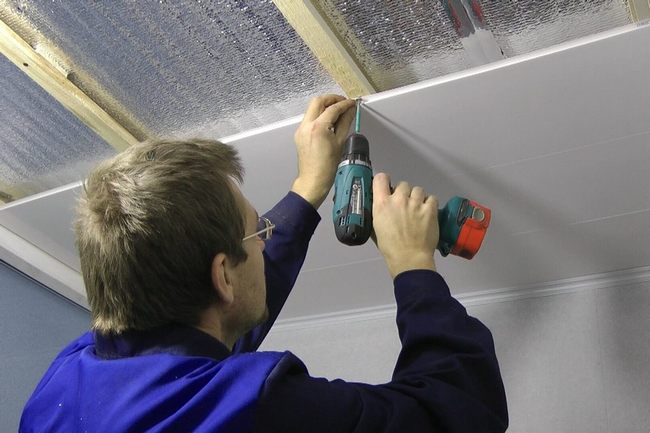
Insulation of balconies, loggias, terraces
If you study carefully, you will have no difficulty isolating these rooms. However, when insulating balconies, one should not forget about the need to maximally lighten the structure in order to avoid an accident.
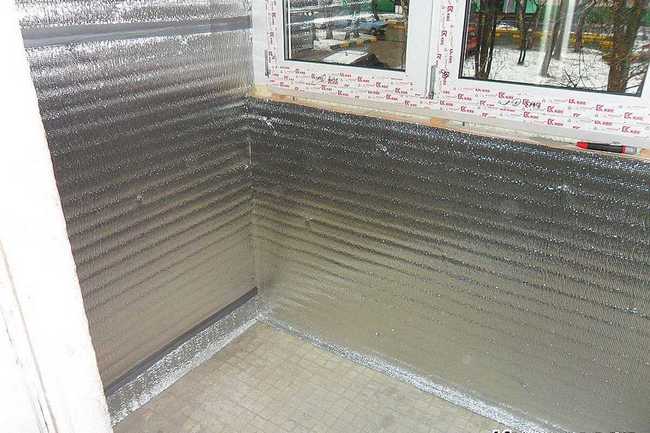
Insulation of a wooden house
Penofol installation technology is no different from technologies in brick, cinder block or other houses. But it is worth noting that, due to the high waterproofing feature of penofol, its installation on wooden walls both outside and inside should be carried out exclusively in the summer, at least after several hot days.
In no case should the house be insulated if the tree is swollen after rains and saturated with moisture. After sheathing the house, it will forever remain inside, and the tree will simply rot, destroying your home.
When insulating walls and ceilings, one must not forget that the aluminum coating has a very high electrical conductivity. In no case should it be placed next to poorly insulated wiring, this can lead to an instant fire in a large area of \u200b\u200bthe room! Before assembling the structure, you must carefully check the wires and insulate them well!
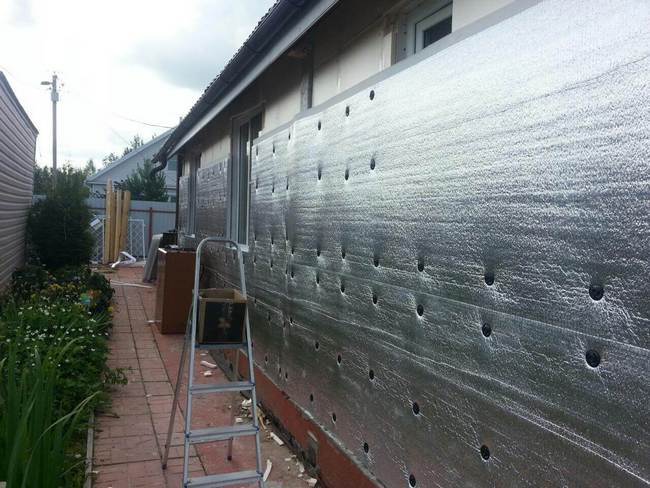
disadvantages
Despite its amazing physical performance and relative ease of use, this material has several disadvantages:
- It is somewhat more expensive than traditional insulating materials, but much more effective - so this can be called a justified disadvantage.
- Penofol cannot be used as an independent element; it must be combined with heavier and more massive insulation like foam or expanded polystyrene.
- Care must be taken during installation, because the gas-foam base is very fragile, and unnecessary damage to the material is useless.

Video
From the video you will learn how to insulate a house with penofol.
Penofol is a foil-clad polyethylene foam. The specified material consists of a layer of polyethylene foam and aluminum foil. Heat can be transferred from one body to another by convection, conduction and thermal radiation.
Most insulation materials only inhibit one type of heat transfer. Due to its structure, the material perfectly reflects heat and does not allow convection. The technical characteristics of this insulation for providing thermal insulation with a thickness of 10 mm are 4 times higher than brick wall 50 cm thick.
If you look closely specifications penofol, you can see that it is not only an excellent insulation, but also lightweight, easy to install, vapor-proof and partially protects against harmful radiation.
The technical characteristics that foil penofol has make it possible to use it for insulation of the most various objects, from an ordinary house or bath to various pipelines.
Foil penofol is a representative of the so-called reflective insulation. The fact that its pores are closed and the foil is polished allows it to achieve very high heat conservation rates.
Penofol replaces vapor barrier and waterproofing materials, which significantly reduces the cost and speeds up the process of house insulation.
Most often, foil-clad penofol is produced in three types:
- class "A" has a foil on one side only, it is usually used to insulate walls, roofs from the inside and engineering systems... There are other materials for insulating a roof with an attic; you can learn about their use from;
- class "B" has foil on both sides and is used to insulate internal partitions and interfloor floors;
- class "C" has foil on one side, and its other edge is covered with glue, which allows installation in difficult conditions and inconvenient places.

Types and types of penfall
Modern industry is constantly expanding the assortment and there is already foil foil foam with other types of foil, it can have internal reinforcement, be perforated and have other technical characteristics. This insulation is produced in rolls, its thickness can be 3, 4, 5, 8, and 10 mm.
Features of foil-clad penofol:
- A wide range of products. Since foil-clad penofol is produced different types, you can always choose exactly the type that is suitable for a specific case and for a specific room.
Safety and low cost. This insulation is environmentally friendly, so it can be used to insulate a building both outside and inside.
Since the use of waterproofing and lathing is not required, the installation of this material is much cheaper than other insulation materials. If we talk about the cost of penofol itself, then it will depend on its type. Average 1 square meter penlofol type "A" will cost from 45 to 70 rubles, "B" - 65-95 rubles, "C" - 110-250 rubles.
The versatility of the material. In addition to the fact that the room is insulated with penofol, its technical characteristics allow it to be used as a vapor barrier, this material perfectly dampens sound, because it has high soundproof characteristics. The versatility of this insulation allows you not to use various films, membranes, which provide waterproofing.
Another feature is that the use of penofol is possible both indoors and outdoors, since it is not afraid of high humidity. Most other heaters are designed to be installed either inside or outside the home.
Small material thickness. The thickness of this insulation is much less than that of similar insulation, so if it is mounted inside a room, then in this way, you take away the minimum amount of its free space.
If, in order for the insulation to be effective, the thickness of other insulation must be at least 50-100 mm, then this has a thickness of only 3-10 mm, but at the same time it thermal insulation characteristics not worse, and sometimes better.
High quality. Advanced manufacturing technology ensures that after warming with the specified material, heat loss will be no more than 4%.
Another advantage of penofol, unlike other heaters, is that it not only retains heat, but also directs it back into the room. Its structure does not allow moisture to penetrate through the material, so its application is possible at temperatures from -60 to +110 degrees. Foil penofol works on the principle of a thermos, so it will be warm in your house in winter and cool in summer.
Ease of installation. Due to the fact that this insulation is produced in rolls and has a plastic structure, it is easy for them to insulate not only flat surfaces, but surfaces of complex shapes, corners and other elements.
For installation, no additional frame construction is required, since it is lightweight and can be attached directly to the insulated surface.
In order to separate a piece of penofol, necessary in size, it is enough to have ordinary scissors. All work can be carried out independently, even such complex ones as insulation of pipes, cables and other communications.
Note that you can use it to heat pipes, which is quite realistic to implement on your own.
If you are faced with the problem of a cold floor in a private house or apartment, then you can use either a warm electric floor - or use an expanded clay screed, in more detail in the article about.
Another option in this case is the insulation of the foundation, but we note that the work can only be carried out during the warm period.
Application and installation
This material can be used both as a stand-alone insulation and in combination with other materials. It can be simply glued to wooden walls under the finish and thus, you will significantly increase the thermal insulation characteristics of the building.
Penofol can be used not only to insulate walls, it is used to insulate a warm floor and ceiling. Installation can be done by hand without the involvement of specialists.
For fastening to a wooden wall, you can use glue, a stapler or nails, the seams must be glued with aluminum tape so as not to violate the integrity of the insulation layer. The reflective side of the material should be directed towards the room.
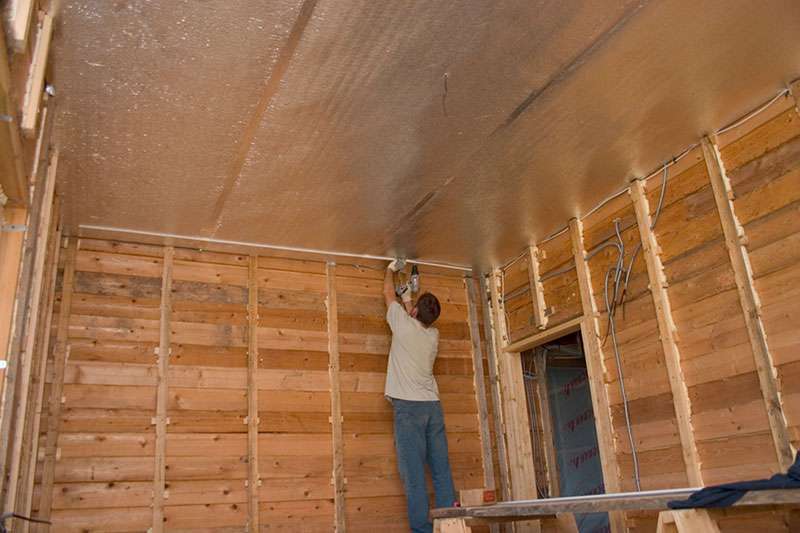
Foil foam is used to insulate hoods and air ducts, it is easy to do, since it is very elastic. Another advantage is that installation can be carried out at any time of the year. You do not need to have special equipment for installation.
Between penofol and the rest finishing materials, it is necessary to leave a gap for ventilation so that moisture does not accumulate. If we talk about the service life of the specified insulation, then we must remember that it is based on polyethylene foam, and its service life is more than 200 years, therefore, penofol will serve for more than one decade.
Advice: for insulation, you can also use the "old-fashioned way", namely, the way is ecological and economical.
Often mineral wool and foam are used for thermal insulation - these materials.
Despite the fact that this material has many advantages, like any other insulation, it also has some disadvantages:
- it does not have sufficient rigidity, therefore, you cannot glue wallpaper or plaster on it;
- some people nail penofol with staples, but in this way its thermal insulation characteristics deteriorate, it is better to use special glue or rolls with a self-adhesive base;
- for full-fledged wall insulation, the use of foam foam alone will not be enough, it must be used in combination with other materials.
If during the installation of the specified insulation you accidentally cut it, then this is not scary. The indicated place just needs to be sealed with aluminum tape.
I know that penofol is good remedy for insulation, but there are still questions for specialists. I would like to know about its use as a heater for linoleum in an old wooden country house. There is simply no point in buying something expensive ... the house is quite old, we use it only in summer and autumn, but all the same, the floor is always cold.This material is also suitable for installing a warm floor, for this you need to use penofol A-LP or ordinary A-03, but under it you need to lay a film.
What is foamed foam, what are its technical characteristics, and why did this insulation get such a name? There are many questions regarding penofol. Therefore, in this article I would like to deal with this. thermal insulation material, determine its application and especially focus on its installation.
So, penofol is a heater made of foamed polyethylene, which is covered with foil on one or both sides at once. The thickness of the foil layer is 12-30 microns. But the most important thing is that there are rather stringent requirements for the metal from which the foil is made. Its content of pure aluminum should be 99.4%. Why is it so important? Remember what processes take place in a thermos, why the temperature is kept in it for so long.
 It's all about the metals that cover the surfaces of the thermos flask, polished to a mirror finish. They reflect infrared heat energy and prevent it from leaving the internal volume. True, these qualities are possessed only by noble metals (silver, gold and bronze), as well as aluminum (one of the cheapest metals today). It is used in modern production foil.
It's all about the metals that cover the surfaces of the thermos flask, polished to a mirror finish. They reflect infrared heat energy and prevent it from leaving the internal volume. True, these qualities are possessed only by noble metals (silver, gold and bronze), as well as aluminum (one of the cheapest metals today). It is used in modern production foil.
It should be noted that metals have high thermal conductivity. Therefore, so that heat does not penetrate through them and leave, in addition to the foil (metal), a heater is added. In the case of penofol, it is polyethylene foam. By the way, the very name "Penofol" is not the name of the insulation, it is the name of the brand.
Important... When installing penofol, it is necessary that its foil side faces into the premises. If it concerns roof insulation, then with foil inside the attic or attic.
Penofol parameters
Currently, a large number of different types of insulation are produced under the Penofol brand, which are divided into classes.
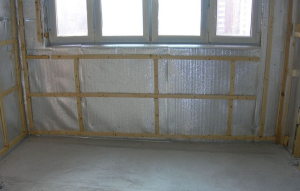
As for the position "technical characteristics", it should be noted that the qualities and properties of penofol are based on expanded polyethylene. Here are its specifications:
- thermal conductivity - 0.044-0.051 W / m K;
- density 25-50 kg / m³;
- thermal reflection coefficient - 97%;
- vapor permeability - 0.001 mg / m h Pa;
- compressive strength - 0.035 MPa;
- can be operated at temperatures from minus 40C to plus 100C;
- has a low water absorption on average 0.6;
- does not interact with either chemical elements or biological.
Penofol installation methods
How it is possible to carry out the installation of Penofol class "C" has already been described above. What about other species?
In principle, there are no special installation conditions. Penofol can be used to insulate various structures of the house, namely: walls, floors, ceilings, roofs, foundations, and so on. In fact, it is a universal heat insulator. The only point you need to pay attention to is how to fix penofol.
If it comes to horizontal surfaces, on which the material is laid and attached from above, then it is simply laid out, for example, on the floors overlapping with respect to the strips, and fixed along the walls. That is, the strips of penofol are spread on the floor base with an approach to the walls to a height of up to 15 cm. These edges are fastened with self-adhesive aluminum tape. The same tape must be glued at the joints of the strips, thereby creating the tightness of the thermal insulation structure.
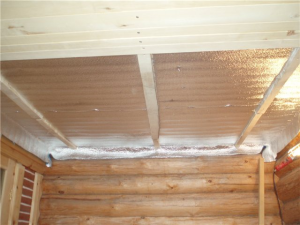 As for the insulation of the roof with foam foam, it can be attached to the rafters with studs with a wide head, self-tapping screws or metal brackets. The last option is simple, fast and convenient.
As for the insulation of the roof with foam foam, it can be attached to the rafters with studs with a wide head, self-tapping screws or metal brackets. The last option is simple, fast and convenient.
For insulation with penofol, it is necessary to consider what class of insulation can be used and fixed in one place or another. That is, the application is determined.
- If floors or walls are insulated, then types "A", "B", and "C" are best suited.
- If penofol is stacked and attached under heating system "Warm floor", then the best option is type "A".
- Penofol class "B" is best used to insulate the floors of the first floor of an apartment building, under which there is an unheated damp basement.
- If on top of a warm floor will ceramic tile, it is best to use "ALP" brand foam for insulation.
Advice... Installation of insulation "A" under warm floors is carried out so that the foil side of the material is directed down to the floor. If you turn the heat insulator, then it will have to be covered from above with a plastic wrap not less than 0.2 mm thick.
Installation example 
Cement mortar has a detrimental effect on aluminum foil. If they come into contact during installation, the foil will not last long. Therefore, when using penofol under a screed, it is necessary to take into account some of the nuances of the process.
So, the installation diagram:
- On the prepared surface of the floor base, strips of foil material are laid with an approach to the walls.
- Penofol edges must be glued (secured) with self-adhesive aluminum tape. The same goes for the strip joints.
- Perpendicular to the laying of the insulation, a polyethylene film is installed with the same approach to the walls and fastened with construction tape.
- Underfloor heating installation and connection is in progress.
- The screed is poured. If, in terms of repair, the floor is finished with tiles, then you can do without a screed. That is, the tiles are immediately laid on warm floors, while it must be fixed, as usual, adhesive composition for ceramic tiles.
The nuance of installing penofol in this case is that the insulator itself must be protected with plastic wrap. When it comes to insulating walls or ceilings with foam foam, the best option is not to glue it, but to lay it under or on the crate.
Let's summarize all of the above. To begin with, the characteristics of penofol, with its fine structure, are quite high. So this is one of the hallmarks of the highest quality. Plus the ability to carry out the process of warming with penofol with your own hands. But the most important thing is to get the right approach to the issue of precise application.



